Hockey 101: A noob's guide to the fastest game on ice
This is for the noobs.
As in hockey noobs. Newbies. People new to hockey.
People who have either just moved here and know nothing about this game played by those who strap razor blades to their feet, don head-to-toe armour and chase a disc of hard rubber around an iced surface with curved sticks at relatively high speeds, or who didn't really care for it in the first place and ignored it.
Until, perhaps, the hometown Edmonton Oilers went on a playoff run last spring through the National Hockey League playoffs to the championship: the Stanley Cup Final.
Maybe then they noticed the team's logo on several car flags adorning one in 15 vehicles across the city in an informal survey taken last spring, or people wearing all manners of blue-and-orange garb featuring that oil-drop-laden brand.
Maybe they noticed the fever, including that feeling when you go to bed late but happy the team won and notice a spring in your step the next morning that wasn't necessarily there before.
Then before you know it, you've plunked down hundreds of dollars to wear an oversized polyester replica uniform and you're calling in sick to work so you can line up to join thousands of people downtown to watch, as a collective, the ebb and flow, highs and lows, high-fives and anguished cries of playoff games on a big screen. Or you ditch yoga and watch it all on TV at home.
'But Craig,' you might ask, 'you're writing and publishing this on a website in Canada! IN EDMONTON! The hockey home of the world's best player, Connor McDavid, and the place where all-time legend Wayne Gretzky, who publicly shamed dozens of goalies and whose likeness could be found on cereal boxes, bed sheets and Barbie dolls ACROSS THE COUNTRY, is lionized in bronze."
True.
But not everyone who lives in Canada follows the game, even though it's the country's unofficial official sport.
Hard for the hardcore hockey fan to understand, I know.
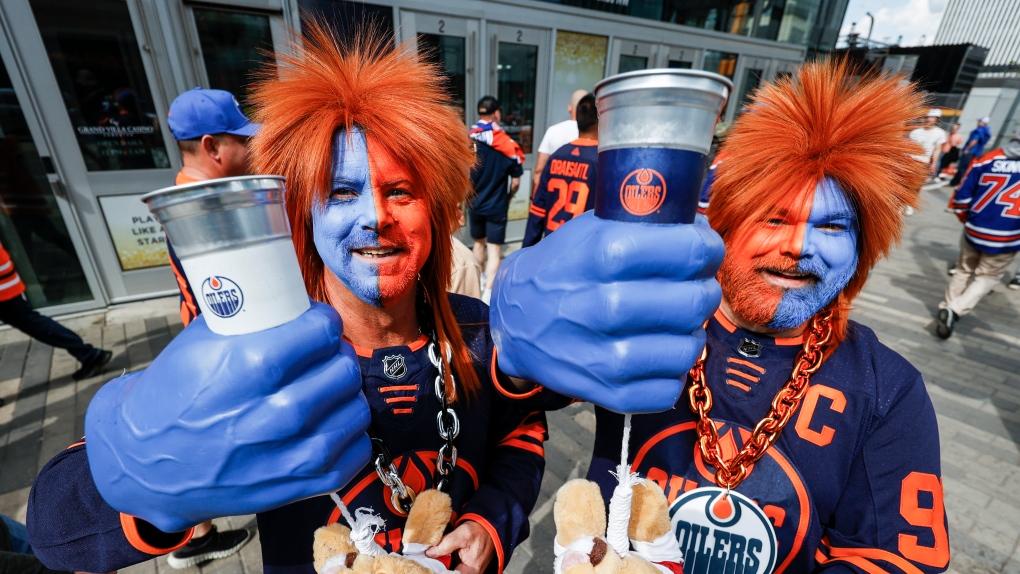 Edmonton Oilers fans Richard Schultz, left, and Brandon Lyle arrive for Game 6 of the Stanley Cup Final against the Florida Panthers in Edmonton on June 21, 2024. (Jeff McIntosh/The Canadian Press)It's hard to escape the Oilers in this town. Flags flutter on city-maintained poles across town flying team colours and slogans.
Edmonton Oilers fans Richard Schultz, left, and Brandon Lyle arrive for Game 6 of the Stanley Cup Final against the Florida Panthers in Edmonton on June 21, 2024. (Jeff McIntosh/The Canadian Press)It's hard to escape the Oilers in this town. Flags flutter on city-maintained poles across town flying team colours and slogans.
Team merchandise is available everywhere. Screens in public display their games. People wear jerseys bearing names and numbers of fourth-line plugs, purchased for full price, to dinner without shame. Adults pay to play the sport with game start times of 11:30 p.m. then wake their kids up five hours later to get them to Saturday morning practice in New Sarepta.
I'm shaking my head, too. (There is something to be said for chasing pucks after midnight, for post-practice Timbits and for staying warm at restaurants, though.)
People move here from elsewhere all the time, though, from places where hockey maybe isn't 'quite' as in focus as it is in Edmonton, the hemisphere's northernmost city that's home to a major professional sports team.
Some are from here but couldn't be bothered in the same way some can't be bothered to pay for a gym membership and actually use it.
And now they're interested. They, too, are curious about this deranged euphoria that comes when a community's team is on the cusp of a Cup. They want to better understand the game and need help doing it.
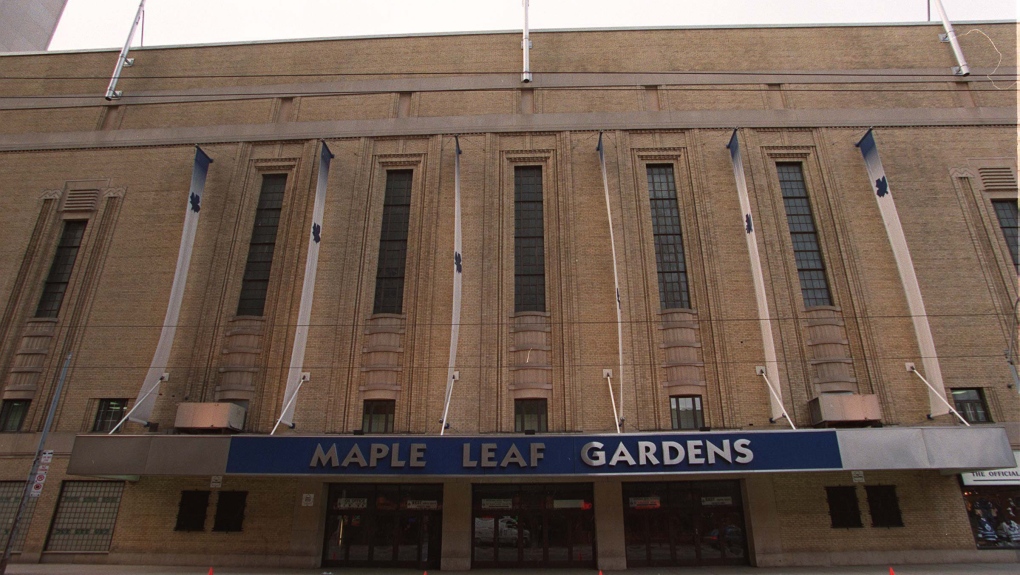 Toronto's Maple Leaf Gardens in 1997. (Frank Gunn/The Canadian Press)Have you – yes, you, the lifelong Canadian who's had to put up with Toronto Maple Leafs games dominating sports TV at 5 p.m. each Saturday since half the population had full ashtrays and jewel-coloured carpet in their living rooms – ever sat back and wondered where the heck the term 'Top Cheddar' came from? What was wrong with keeping it at 'Top Shelf'? And what's with all the food-related hockey slang anyway – is a ploy to sell more overpriced sliders (not hockey lingo, by the way. I think) at concession stands?
Toronto's Maple Leaf Gardens in 1997. (Frank Gunn/The Canadian Press)Have you – yes, you, the lifelong Canadian who's had to put up with Toronto Maple Leafs games dominating sports TV at 5 p.m. each Saturday since half the population had full ashtrays and jewel-coloured carpet in their living rooms – ever sat back and wondered where the heck the term 'Top Cheddar' came from? What was wrong with keeping it at 'Top Shelf'? And what's with all the food-related hockey slang anyway – is a ploy to sell more overpriced sliders (not hockey lingo, by the way. I think) at concession stands?
Imagine hearing a stream of such related words describing what's going on in a game.
Sports in general is like that, though. It's related to what author and wordsmith William Zinsser once said of grammar related to sportswriting: there's Good English, then there's Sports English. The language and talk around sports, including hockey, is different. They don't teach it in school.
As noobs read to the end (sorry, no TL;DR), perhaps they'll learn something new, have an 'a-ha' moment about what it all means.
The puck drops on the NHL season Tuesday night. The Oilers open their 2024-25 campaign on Wednesday at home against the Winnipeg Jets.
And if ...
If you have more terms to share that I might be missing or perhaps a better description of one, send me a message so we can consider adjusting the list. While I like to think I know many things about hockey, I don't think I'd win in an all-NHL edition of Stump The Schwab (R.I.P. Howie Schwab). I know that at least two of my cousins, my Aunt Hilda in Toronto, several former and current colleagues, and a few friends would beat me if we were to appear on that ESPN game show if it was still on the air.
Structure of a hockey game
- The goal of a game, like in several other popular spectator sports, is to record more goals than the opponent to 'win' the game, which is then noted in the standings. The losing team will be assigned a 'loss.'
- A win earns a team two points in the standings. A loss in overtime or in a shootout earns the losing team a single point (a point of contention for some fans).
- A game is broken into three periods of 20 minutes, with 18-minute intermissions between the second and third periods.
- The standard length of a regular-season NHL game is 60 minutes.
- Teams have six players on the ice during game play, usually one goalie and five skaters who play different positions, three of them on a forward line and two on defence.
- If the teams are still tied, they play five minutes of overtime using one goalie and three skaters a side, known as three-on-three play.
- If they're still tied after that, the game goes to a shootout, in which each team sends three skaters to try scoring on the opposing goalie on a breakaway. Whichever team scores more goals with the three skaters wins.
- If the two sides are still tied, they use a single-attempt format, sending one skater at a time until one team scores and the other doesn't.
- In the playoffs, the NHL doesn't use this format for overtime. It adopts what's called 'sudden death': whoever scores first wins. They play overtime periods of 20 minutes with intermissions in between them.

Basics
Rink: term for the ice surface on which hockey is played. The standard dimensions of a North American rink is 200 feet by 85 feet.
Face-off: the act by an official of dropping a puck at a faceoff dot between the sticks of two opposing players lined up and facing each other to begin or resume play.
Offside: when a player on the attacking team crosses the blue line into the other team's zone before the puck and a teammate subsequently crosses the blue line with it after him, officials will stop play for 'offside.' It results in a faceoff on the dot nearest the point of entry in the neutral zone near the blue line. This rule has its roots in soccer and rugby in which legal passes can only be made to teammates who are 'onside' and not simply wait in a favourable spot (like, say, next to the goalie) to receive a pass for a shot on goal.
Icing: this happens when an official stops play after a player shoots the puck from his team's side of the centre line, untouched by the opposing team, and it crosses the goal line on either side of the goal without going into it. It results in a faceoff being held in the shooting player's defensive end. One wrinkle: a team can ice the puck without play being stopped with a resulting faceoff if it is shorthanded.
Player positions
Goalie (goaltender, netminder)
The player whose primary task is to stop pucks from entering his team's net/goal. The goalie wears special protective equipment such as a goalie mask, arm/chest/torso protection, pants that feature additional padding, exterior leg pads, gloves designed to block and catch the puck, a stick featuring a 'paddle' and a wider blade than a standard player's stick, and skates with additional armour and longer, thicker, flatter blades for stability and better gliding capability.
Defenceman
One of two players whose primary task is to prevent the opposition from scoring goals in several ways in an effort to limit the amount of time the opposing team spends in the attacking zone.
Centre
The position on a forward line who lines up between two wingers and takes faceoffs. They are generally considered the playmakers on a line and are usually charged with being the first forward to head back to the team's defensive zone to help defencemen when the other team has the puck.
Wing (winger)
The players who form a line with the centre and line up beside him on faceoffs play left wing and right wing. A winger generally plays on one side of the rink through the three zones, assuming offensive responsibilities when his team has the puck and defensive ones without it.
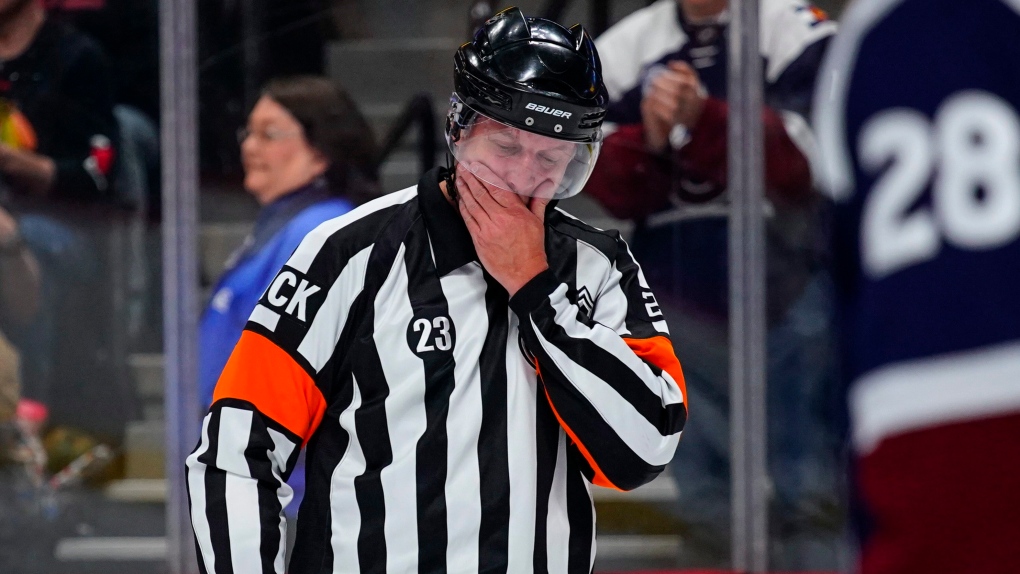 A referee during the first period of an NHL hockey game between the Colorado Avalanche and the Chicago Blackhawks, Saturday, March 23, 2019 in Denver. (AP Photo/Jack Dempsey)
A referee during the first period of an NHL hockey game between the Colorado Avalanche and the Chicago Blackhawks, Saturday, March 23, 2019 in Denver. (AP Photo/Jack Dempsey)
Officials
Referee
The on-ice official who is responsible for enforcing the rules of play. The NHL uses two referees during a game. A referee drops the puck at centre ice to open games and periods, and following goals.
Linesman
The on-ice official whose primary responsibility is to watch for infractions involving the lines, including offside and icing, after which they drop the puck for faceoffs. Like referees, the NHL uses two linesmen for games.
Off-ice official
Several officials work off the ice – either near the ice surface, somewhere in the stands or in an arena's press box or on a catwalk – including the official scorer, the game timekeeper, the penalty timekeeper, statisticians, goal judges and a video goal judge.
All about penalties
Minor penalty: an infraction in which a player sits in the penalty box for two minutes as punishment.
Major penalty: five minutes in the penalty box as punishment for an infraction deemed 'major.'
Match penalty: a major penalty and immediate removal of a player from a game following that player's attempt to injure an opponent.
Game misconduct: a penalty that sees the offending player ejected for the rest of a game and sent to the dressing room for the duration of it. Acts by a player that can lead to a game misconduct include intent to injure an opponent and verbal abuse of officials.
A game misconduct penalty on its own does not result in time lost by the offending player's team, so no player sits in the penalty box and the opposing team isn't awarded a power play. Typically, however, a game misconduct is assessed alongside another penalty, usually a major, at an official's discretion.
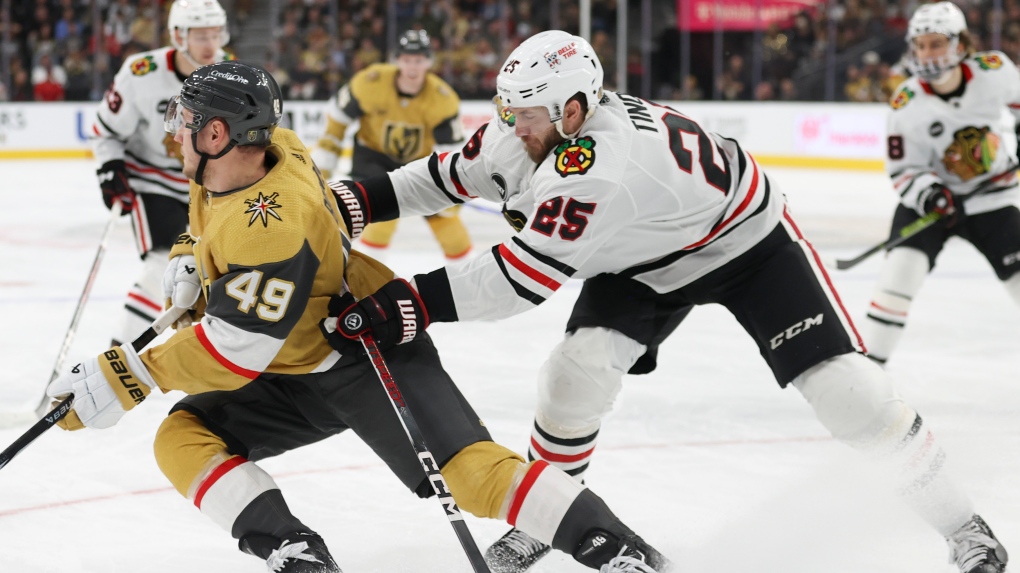 Chicago Blackhawks defenseman Jarred Tinordi (25) cross-checks Vegas Golden Knights centre Ivan Barbashev (49) during NHL action on April 16, 2024, in Las Vegas. (Ian Maule/Associated Press)
Chicago Blackhawks defenseman Jarred Tinordi (25) cross-checks Vegas Golden Knights centre Ivan Barbashev (49) during NHL action on April 16, 2024, in Las Vegas. (Ian Maule/Associated Press)
Infractions you need to know
Boarding: A player can legally check or slow down/stop an opponent along the boards but when a player pushes, trips or checks an opponent dangerously into the boards, usually from a short distance, a major penalty is called.
Charging: a player who takes two or more strides before making body contact with an opposing player, or whose feet leave the ice before such contact, can be given a charging penalty. It can be a minor or major penalty depending on the severity of the action.
Cross-checking: an illegal move by a player using the shaft of his stick between his hands with no part of the stick on the ice to check an opponent.
Delay of game: a penalty that results after a player stops a game in one of several ways, including:
- by shooting or throwing the puck out of play;
- by shooting the puck over the glass in his defensive zone before it reaches the blue line;
- by intentionally knocking the goal off its moorings;
- if a player intentionally keeps the puck behind his goal for more than one minute;
- an unsuccessful coach's challenge;
- if a player besides a goalie uses his hands to prevent the puck from being played;
- and if fans disrupt the game or throw objects onto the ice.
Elbowing: a penalty called when a player extends his elbow and makes contact with an opponent with it. It can be either a minor or a major penalty depending on the severity of the play.
Fighting: defined by Hockey Canada as an act resulting in a penalty that occurs when at least one player punches or tries to punch an opponent repeatedly or when two opposing players wrestle. Related: an instigator penalty, worth two minutes, and a 10-minute misconduct is given to a player who clearly initiates a fight.
High-sticking: a minor penalty given when a player makes contact with an opponent with his stick above his shoulders.
Holding: a minor penalty given to a player who impedes an opponent by grabbing them in some fashion, whether clutching their jersey, stick or body.
Hooking: a minor penalty is given to a player who uses the blade of his stick to hamper an opponent.
Interference: a minor penalty given when a player:
- constrains an opponent without the puck, whether by blocking their progress, checking them or forcing them offside;
- knocks an opponent's stick from his hands or preventing him from retrieving it after dropping it;
- inhibits an opponent or the puck from the bench.
Misconduct: a 10-minute penalty to a player that does not lead to a power play for the other team. Officials generally give a player a misconduct penalty for rough conduct while play is stopped and to calm emotions. The player sits in the penalty box for a misconduct penalty unless it is given with 10 or fewer minutes left in a game, when the player is sent to the dressing room instead.
Slashing: a minor penalty given when a player strikes an opponent with his stick by swinging it as though he was chopping wood with an axe or beating a rug with a stick (whether a 'regular' stick or a hockey stick; I've used both).
Spearing: the act of jabbing an opponent with the toe of a stick (the end of the blade), resulting in a major penalty and a game misconduct.
Tripping: a two-minute penalty is given to a player who trips an opponent, usually when the player's stick is involved in striking his legs. Tripping via a 'slew-foot,' which happens when a player uses their foot or leg to take out an opponent's legs from behind, can result in a major penalty depending on the severity of the play.
Related penalty terms
Penalty killing: a.k.a killing a penalty, the penalty kill. Actions by a team when shorthanded to prevent the opposition from scoring.
Power play: a situation a team finds itself in when opposing players take penalties and leave the ice for the penalty box, giving the team an advantage because it has more players on the ice, giving them a better chance to score a goal.
Matching penalties: a.k.a. coincidental minors - minor penalties given to players from opposing teams that offset each other. Each team continues play at full strength, five skaters each, while the offending players serve their penalties.
Penalty box: a.k.a. The Box, Sin Bin. A bench area on the opposite side of the ice from team players' benches where players sit to serve time for a penalty.
Penalty shot: A free shot on a goalie without any other defenders in the way awarded to a player who was illegally interfered with by an opposing player while on a clear breakaway scoring chance. The player awarded a penalty shot starts skating with the puck toward the goalie from the centre faceoff dot.
Man advantage: also: two-man advantage. Another way of saying a team is on a power play is to say they have the 'man advantage,' when they have more skaters on the ice than the opponent.
Shorthanded: a situation a team is in when it has one or two players less than the opposing team on the ice because of penalties.
Power-play quarterback: the player, usually a defenceman, who plays the point during his team's power play. He generally dictates the flow of the offence when a team has a man advantage as he is usually far enough away from opponents that passing the puck to him can act as a safety valve of sorts for forwards if they can't make a play. The power play QB, at his vantage point, can then look for another, better opportunity for a pass or shot.
Lingo
A: the letter 'A' stitched to the upper front corner of a player's jersey indicates he is an 'A'lternate captain. You could say, 'That guy is wearing an/the 'A''
Apple: an assist.
Arena: the venue at which a hockey game is played. Also known as the rink.
Assist: a statistic that credits one point to a player who passed the puck to a teammate for a goal. Up to two assists per goal are awarded (known as primary and secondary assists).
Attacking zone: refers to the other team's zone from the blue line to the end boards.
Back check: the act of chasing the opposing team's players when they have the puck and are on the attack.
Bar down: a player is said to go 'bar down' when his/her shot hits the bottom of the goal's crossbar and enters it for a goal.
Barn: an arena.
Beauty: a.k.a. Beautician. Refers to a player who is admired for his skills and for unique qualities such as his personality, style and/or demeanour.
Biscuit: a goal.
Blue line: the blue line serves more than one purpose, both formally and informally. It officially marks the point at which, if a attacking player's skate crosses it before the puck is already in the other team's zone and a teammate subsequently enters the zone with the puck, play is stopped by the officials for offside.
Boards: a.k.a. half wall, dasher boards. The white low wall – filled with advertisements in many arenas – that bounds the ice surface.
Body check: body contact, whether along the boards or in the middle of the ice, by a player on an opponent carrying the puck. It's illegal to body check a player who isn't carrying the puck.
Breakaway: a situation when a player with the puck skates toward the other team's goalie with no other opposing players between them.
Butt-ending: a player's use of the end of his stick's shaft to (illegally) jab an opposing player.
C: the letter 'C' stitched to the upper corner of the front of a player's jersey to indicate he's captain of the team. 'He's wearing the 'C.'
Call Toronto: A reference to the National Hockey League's Situation Room: the centralized video replay office located in downtown Toronto at league headquarters where officials oversee, review and scrutinize plays in all games with multiple video cameras at arenas, some of which are exclusive to it.
Cage: usually refers to the goal or net, or it can mean the wire mask worn by goalies or, at times, forwards/defencemen.
Celly: short for celebration of a goal.
Centre line: the red line that runs across the middle of the ice, intersected by the faceoff circle with a faceoff dot in the middle. All faceoffs to start a period or following a goal take place at this dot.
The centre line also plays a role in determining icing. If a player sends the puck from his team's side of the ice across the centre line and it crosses the goal line (without going into the goal itself) without being touched by another player, the play will be whistled dead for icing.
Checking: An all-encompassing term for several (legal) forms of trying to take the puck away from the other team. There are several forms of checking, including: back check, fore check, body check, hip check, shoulder check, poke check, stick check, cross-check and lift check.
Chiclets: teeth, perhaps not in a player's mouth and on the ice instead. Pros generally don't wear full face protection. Unfathomable, I know. Akin to riding a motorcycle or skiing without a helmet, I'd say.
Chip: the act of lifting the puck while shooting it off the boards, known as 'chipping it off the boards.'
Chirp: an insult, sometimes meant in fun or jest, directed by a player at an opponent. Also known as chirping.
Clearing the puck: a player's or team's moves to get the puck out of their defensive zone.
Crease: the area in front of a team's goal painted blue that's generally occupied by a goalie.
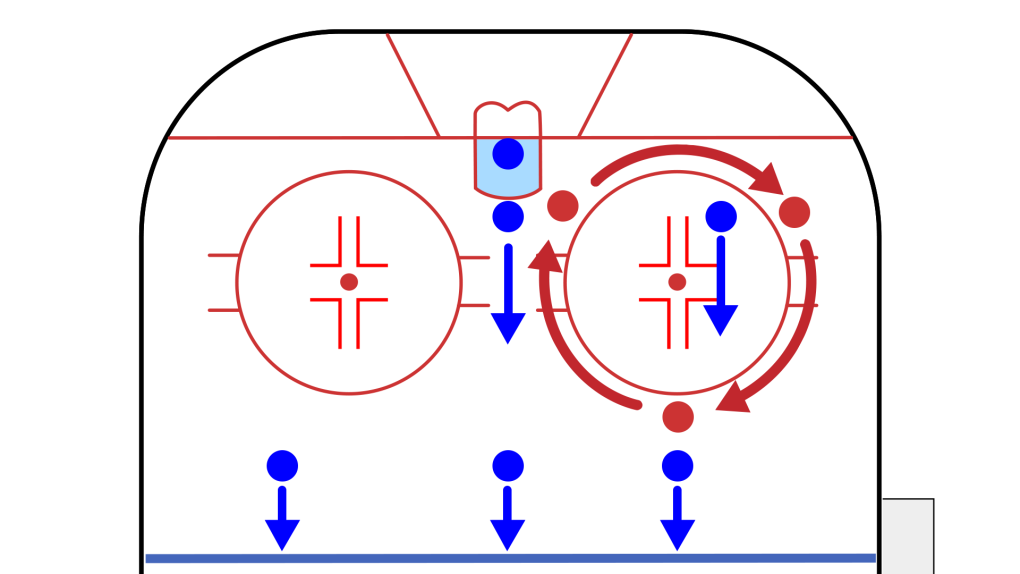 A diagram demonstrating (trying to, at least) 'cycling' in hockey. Players represented by red dots cycle the puck.Cycling: an offensive strategy by a team in the opponent's zone that sees players constantly pass the puck among each other to outmaneuver opponents and create a good scoring chance.
A diagram demonstrating (trying to, at least) 'cycling' in hockey. Players represented by red dots cycle the puck.Cycling: an offensive strategy by a team in the opponent's zone that sees players constantly pass the puck among each other to outmaneuver opponents and create a good scoring chance.
Defensive pair/pairing: two teammates who are partners on defence. They typically play together on a 'shift,' one of them generally responsible for the left side of the ice, the other the right.
Defensive zone: the side of the ice from the blue line to the end boards in which a team protects its goal. This 'zone' would be the opposing team's offensive or attacking zone.
Deke: an attempt by a player with the puck to deceive an incoming opponent by faking a movement in order to draw him away from the attacker's intended route.
Delayed penalty: this occurs during game play when an on-ice official lifts an arm to indicate a penalty but does not use his whistle to stop play until the team getting the penalty touches the puck.
When the opposing team notices an official signalling a delayed penalty, they generally have their goalie come to the bench to be replaced by an additional skater to try to take advantage of continued puck possession – and potentially score a goal as a result – because when the other team touches the puck, the play will be stopped anyway.
Dots (faceoff dots): there are five spots, indicated by nine painted special circles or 'dots,' on the ice surface where face-offs are generally held: two inside each defensive/attacking zone inside larger faceoff circles, four located outside the two blue lines in the neutral zone
Drop pass: the act by a player carrying the puck to either direct it behind him or stop carrying it, usually between his legs, to give/pass it to a teammate.
Dump and chase: this offensive tactic sees a player on the team with possession of the puck shoot it – once they've crossed the centre line, of course – to the end boards in the offensive zone followed by attacking players skating quickly in a race to retrieve it before the defending team.
Dump truck: a player, typically a forward, who is adept at dumping the puck into the offensive zone and chasing after it, usually a larger player. Also refers to the size and strength of this player's lower body muscles, particularly the gluteus maximus and thighs.
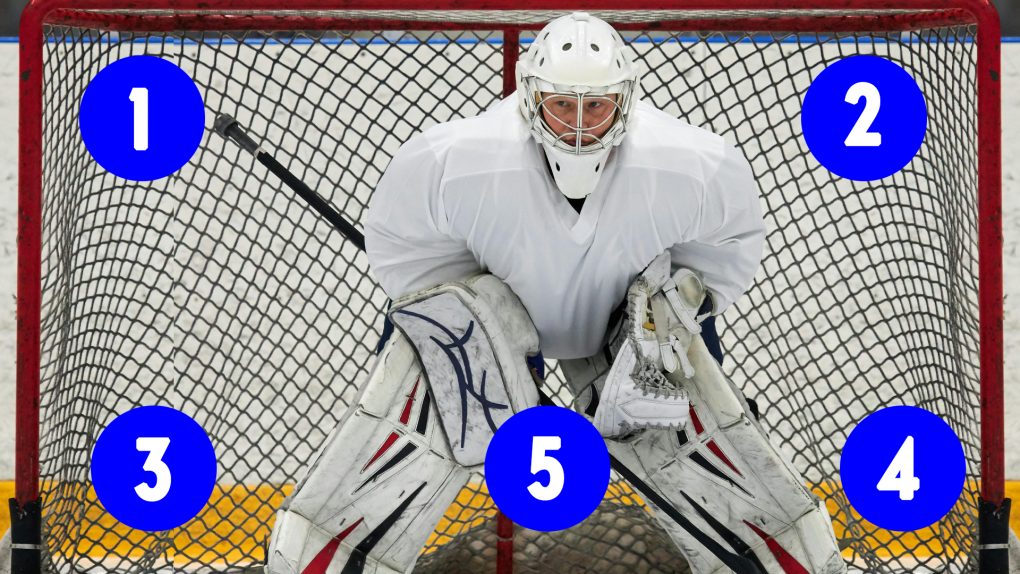 Five-hole: the space between the leg pads of a goalie, (5) in the graphic above. The reason why it's called a 'five' hole is its one of five general shooting targets for an attacking player when approaching a goalie in his net, the other four being:
Five-hole: the space between the leg pads of a goalie, (5) in the graphic above. The reason why it's called a 'five' hole is its one of five general shooting targets for an attacking player when approaching a goalie in his net, the other four being:
- 'high blocker side' or 'high stick side' (1), or the upper corner of the net above the goalie's blocker hand that holds his stick;
- 'high glove side' (2), or the upper corner of the net above the goalie's catching hand;
- 'low blocker side' or 'low stick side' (3), or the lower corner of the net below the goalie's blocker hand that holds his stick;
- 'low glove side' (4), or the lower corner of the net below the goalie's catching hand.
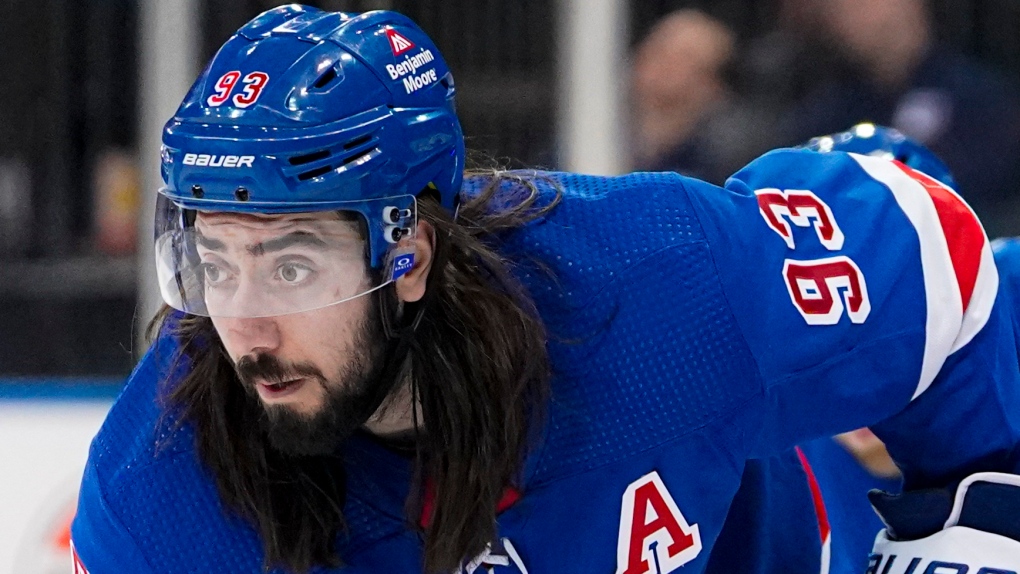 New York Rangers star Mika Zibanejad during NHL action on Dec. 22, 2023, against the Edmonton Oilers. (Peter K. Afriyie/Associated Press)Flow: a.k.a. salad or lettuce. A term of admiration/endearment referring to a player's longer hair style, usually but not exclusively associated with the so-called mullet.
New York Rangers star Mika Zibanejad during NHL action on Dec. 22, 2023, against the Edmonton Oilers. (Peter K. Afriyie/Associated Press)Flow: a.k.a. salad or lettuce. A term of admiration/endearment referring to a player's longer hair style, usually but not exclusively associated with the so-called mullet.
Forecheck: moves by a player on the team without the puck to regain it by skating to the opponent with it and using tactics to reclaim it.
Forward: a general term to describe one of three players playing on a forward line at centre, left wing or right wing.
Freezing the puck: the act of a player, usually a goalie, to stop and hold the puck, leading to an official whistling the play dead.
Goal: refers to:
- a point awarded in a game to a team/player when the puck crosses the goal line and into the net;
- the apparatus that serves as the target of an opposing team that is made up of two posts and a crossbar, all coloured red, with a net fastened/draped in behind to catch the puck;
- or the position of goalie/goaltender.
Goal line: the two-inch-wide red line that runs the width of each end of the ice, each 11 feet from the end of the boards. It serves as the titular goal line and as the marking to help officials determine an icing call.
 Gordie Howe of the New England Whalers, left, delivers one of his well-known elbows to the head of Quebec Nordiques forward Curt Brackenbury on Dec. 17, 1978. (Doug Ball/The Canadian Press)Gordie Howe hat-trick: an unofficial feat recognized when a player records a goal, an assist and a fight in one game. It's named after the man many consider the prototype 'power forward' (if not the best NHL player of all time), a type of player which is skilled both in scoring points and playing so-called 'heavy' hockey, which includes fighting and physical play.
Gordie Howe of the New England Whalers, left, delivers one of his well-known elbows to the head of Quebec Nordiques forward Curt Brackenbury on Dec. 17, 1978. (Doug Ball/The Canadian Press)Gordie Howe hat-trick: an unofficial feat recognized when a player records a goal, an assist and a fight in one game. It's named after the man many consider the prototype 'power forward' (if not the best NHL player of all time), a type of player which is skilled both in scoring points and playing so-called 'heavy' hockey, which includes fighting and physical play.
Grinder: not a hockey dating site but a player, usually a forward, valued for physical play and notable forechecking abilities more than his a knack for scoring.
Hand pass: a move by a player to move the puck using his hands and resulting in a teammate getting possession of it. While illegal, the move does not result in a penalty but officials will stop play if it happens.
Hash marks: short red lines that extend from the edge of the four face-off circles in the defensive/attacking zones used to denote where a player should line up for a faceoff.
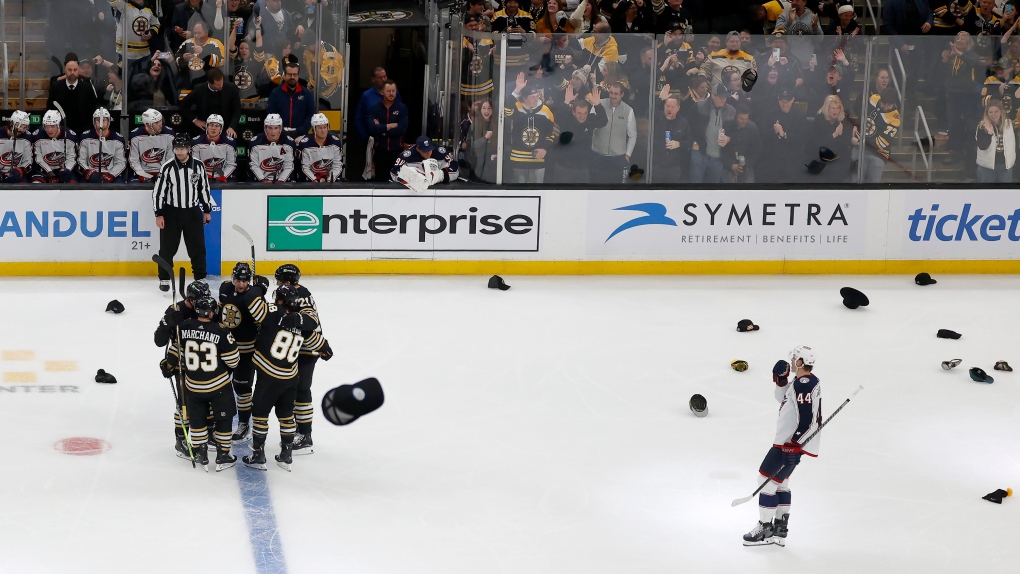 Hats fly onto the ice as Boston Bruins players congratulate teammate Brad Marchand for scoring his third goal for a hat-trick as Columbus Blue Jackets defenseman Erik Gudbranson looks on during NHL action on Dec. 3, 2023, in Boston. (Mary Schwalm/Associated Press)Hat-trick: a.k.a. hatty. Refers to three goals scored by one player in a game. A 'natural' hat-trick occurs when a player scores three goals in a row, without anyone else scoring, in the same period. The term 'hat-trick' was originally used in the sport of cricket, when a team would give a bowler a new hat if he retired three consecutive batsmen with three consecutive balls.
Hats fly onto the ice as Boston Bruins players congratulate teammate Brad Marchand for scoring his third goal for a hat-trick as Columbus Blue Jackets defenseman Erik Gudbranson looks on during NHL action on Dec. 3, 2023, in Boston. (Mary Schwalm/Associated Press)Hat-trick: a.k.a. hatty. Refers to three goals scored by one player in a game. A 'natural' hat-trick occurs when a player scores three goals in a row, without anyone else scoring, in the same period. The term 'hat-trick' was originally used in the sport of cricket, when a team would give a bowler a new hat if he retired three consecutive batsmen with three consecutive balls.
Head-manning the puck: the act of a player passing the puck to a teammate ahead of him who is leading the attack, hence giving it to the head man.
Heavy hockey: generally refers to physical play featuring hard hits administered by larger players.
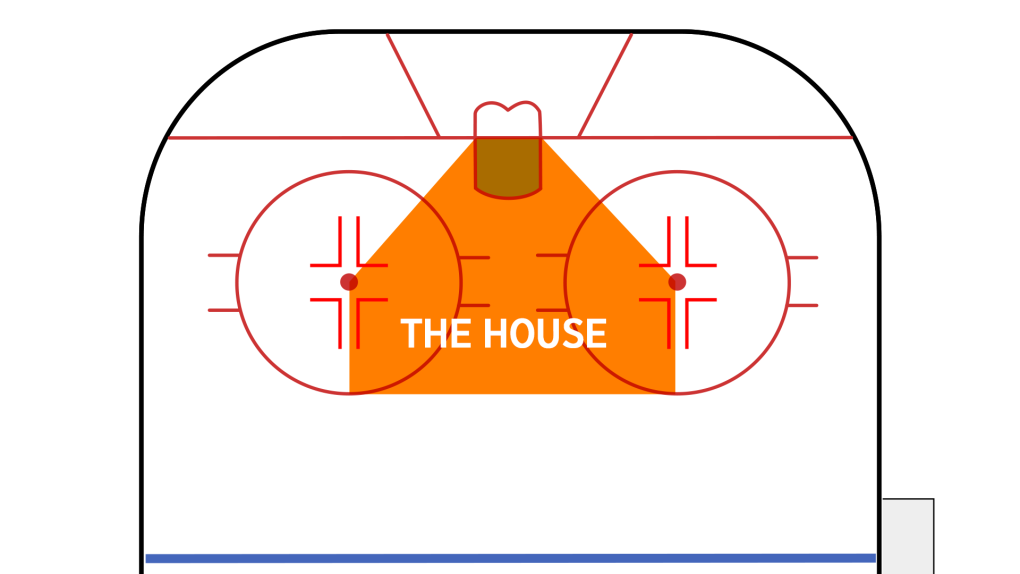 House: an informal term for an area in front of a team's goal that stretches from the goal posts to the faceoff dots and to the 'tops' of the faceoff circles (the parts closest to the blue line). It stems from a defensive concept centred around 'protecting the house.'
House: an informal term for an area in front of a team's goal that stretches from the goal posts to the faceoff dots and to the 'tops' of the faceoff circles (the parts closest to the blue line). It stems from a defensive concept centred around 'protecting the house.'
Hip check: a variation of the body check that occurs when a player crouches and swings his hips toward an opponent to send him off-balance.
Hockey hair: generally a hairstyle that features a mullet. See Flow.
Lettuce: a player's hair. See Flow, Salad.
Line (forward line): the combination/unit of a centre, a left winger and a right winger.
Line change: the replacement of a player or players during the course of a game, whether when play has stopped or while it is active. The latter is known as 'changing on the fly.'
Long change: a factor when a line and/or defensive pairing plays extended minutes in their own zone during the second period, when they defend the end of the ice furthest away from their team bench.
Mitts: this term refers to a) a player's gloves, or b) a player's high skill in handling the puck, known as having 'filthy mitts' or 'silky mitts,' also known as 'good hands.'
Muffin: a goal resulting from a 'soft' shot, one that floated harmlessly to the net and inexplicably went in.
Neutral zone: the area in the middle of the ice between the blue lines.
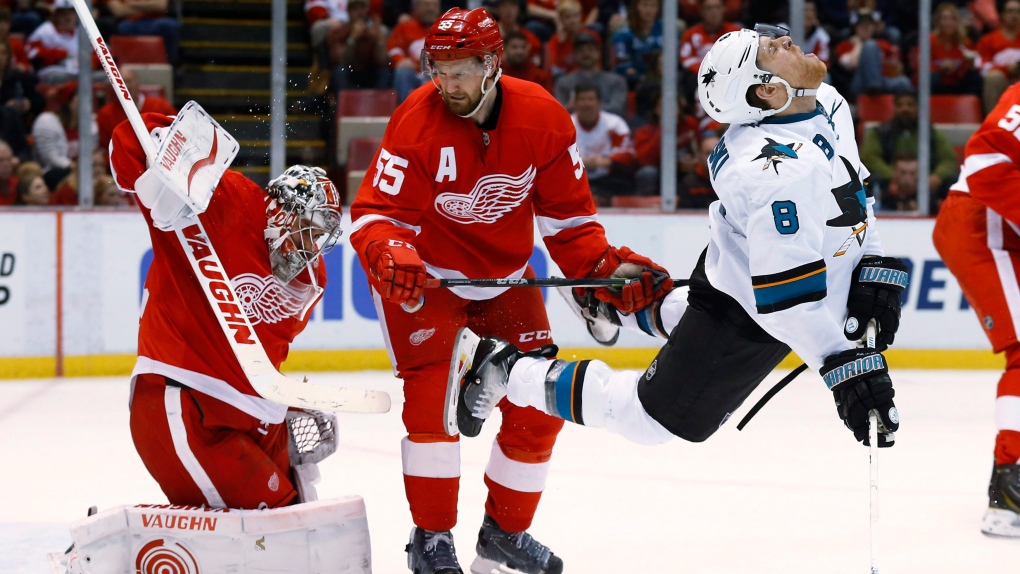 Detroit Red Wings defenceman Niklas Kronwall checks San Jose Sharks centre Joe Pavelski as goalie Petr Mrazek stops a shot during NHL action on March 26, 2015. (Paul Sancya/Associated Press)Kronwalled: to be the recipient of a big hit, preferably from a defenceman, as its namesake is the now-retired Niklas Kronwall, who was known for crushing body checks.Odd-man rush: when an offensive team has more players on the attack than the defensive team has at the moment because other defensive players are behind the play.
Detroit Red Wings defenceman Niklas Kronwall checks San Jose Sharks centre Joe Pavelski as goalie Petr Mrazek stops a shot during NHL action on March 26, 2015. (Paul Sancya/Associated Press)Kronwalled: to be the recipient of a big hit, preferably from a defenceman, as its namesake is the now-retired Niklas Kronwall, who was known for crushing body checks.Odd-man rush: when an offensive team has more players on the attack than the defensive team has at the moment because other defensive players are behind the play.
Offensive zone: a.k.a. attacking zone. One side of the ice from the blue line to the end boards in which a team is trying to score a goal. Conversely, the zone is also the opposing team's defensive zone.
Olympic ice: a.k.a. European ice. Hockey staged during Winter Olympics is played on an ice surface that measures 200 feet by 100 feet, 15 feet wider than the North American standard of 200 feet by 85 feet. European ice rinks measure 60 metres by 30 metres, or 197 feet by 98.5 feet, close to that used in Olympic play.
One-timer: a shot on goal by a player who immediately shoots a moving puck without first stopping it or bringing it under control.
Pinch: this happens when a defenceman tries to keep the puck inside his team's attacking zone by skating to the boards to stop the opponent from clearing the puck, or when he skates from the blue line into the attacking zone to gain a better offensive vantage point, usually to take a shot. In both cases, it's a risk on the defenceman's part because he leaves a defensive position and exposes holes for the other team to potentially exploit.
Pizza: a bad pass up the middle of the ice intercepted by the other team for a scoring chance. A player 'serves up a pizza' when he does this.
Point: the area just inside the blue line in a team's attacking zone usually patrolled by defencemen. Related: point shot, a shot taken from the point area.
Poke check: a forechecking move by a player pushing his stick with one hand to use the blade to knock the puck off an opponent's stick blade.
Plumber: a player considered to have less skill than most teammates but who is a hard worker.
Plus/minus: the difference between the number of goals a player was on the ice for versus the number he was on scored against his team. Players can have a positive or negative plus/minus.
Puck: the black disc made of hard, vulcanized rubber, which measures one-inch thick and three inches in diameter, that is the focus of play in hockey, functioning as a ball does in other sports. Also known colloquially as a 'biscuit.'
Ragging the puck: a term to describe the actions of a player to keep possession of the puck without trying to score in an attempt to use up time.
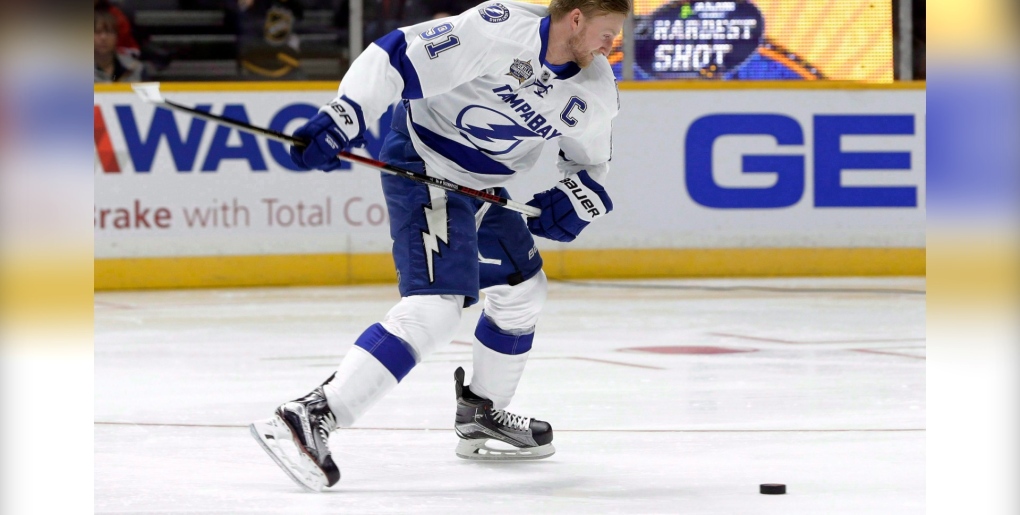 Tampa Bay Lightning forward Steven Stamkos competes in the hardest shot competition at the NHL All-Star game skills competition on Jan. 30, 2016, in Nashville, Tenn. (Mark Humphrey/Associated Press)Slap shot: the act of shooting the puck by a player in which he lifts the blade of his stick backwards (a wind-up) before aggressively hitting, or 'slapping' as that's the sound it makes, the puck during the shot to propel it faster and harder toward the goalie.Salad: a.k.a. a player's hair. See Flow, Lettuce.
Tampa Bay Lightning forward Steven Stamkos competes in the hardest shot competition at the NHL All-Star game skills competition on Jan. 30, 2016, in Nashville, Tenn. (Mark Humphrey/Associated Press)Slap shot: the act of shooting the puck by a player in which he lifts the blade of his stick backwards (a wind-up) before aggressively hitting, or 'slapping' as that's the sound it makes, the puck during the shot to propel it faster and harder toward the goalie.Salad: a.k.a. a player's hair. See Flow, Lettuce.
Saucer pass: a.k.a. saucer, sauce. The act by a player passing the puck to a teammate by lifting it off the ice (like a flying saucer). He does this with the puck by applying pressure on his stick blade during the follow-through motion of passing, giving it 'air.'
Screened shot: a.k.a. screen. Refers to the goaltender being unable to see an opponent's shot because players, often opponents but also teammates, block his vision during it.
Sides: strong side, weak side - the strong side refers to the side of the ice where most of the players are located during play, the weak side being the side where fewer players are at the time.
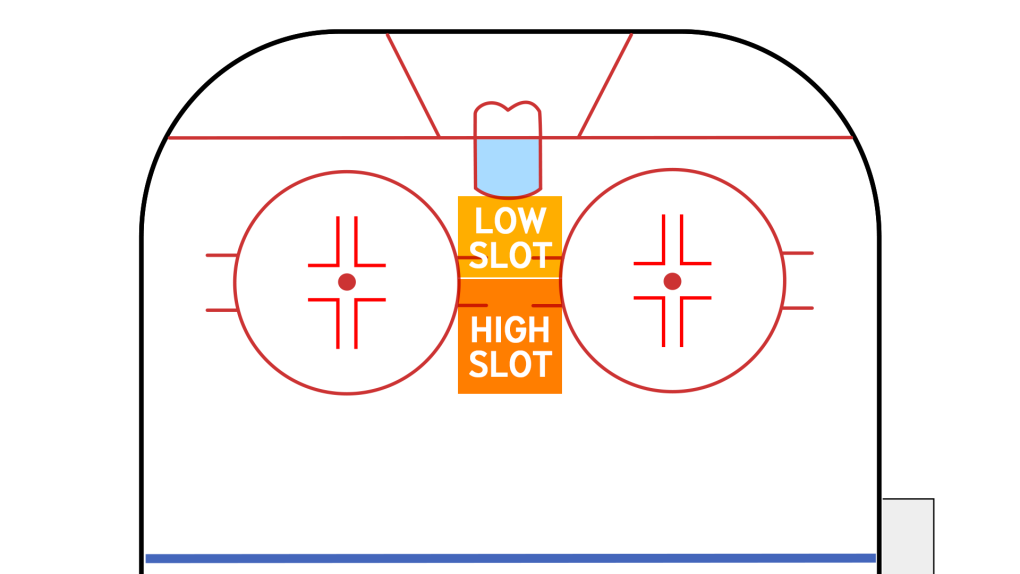 Slot: an unofficial term referring to the area directly in front of the goal crease between the faceoff circles. It is further broken into the 'high slot,' about half of the area that's furthest away from the goal, and the 'low slot,' the half nearest the goal.Sieve: a term for a goalie who has been scored on often, whether during a point in a game ('he let in three goals on five shots, what a sieve!') or over a longer period of time.
Slot: an unofficial term referring to the area directly in front of the goal crease between the faceoff circles. It is further broken into the 'high slot,' about half of the area that's furthest away from the goal, and the 'low slot,' the half nearest the goal.Sieve: a term for a goalie who has been scored on often, whether during a point in a game ('he let in three goals on five shots, what a sieve!') or over a longer period of time.
Shift: the amount of time a player, pairing or line spends on the ice before returning to the team bench.
Stickhandling: refers to a player's skill at manoeuvring the puck during game play.
Sweep check: the act by a defending player in which he lays his stick on the ice while holding it and uses a sweeping motion to knock the puck from an opponent.
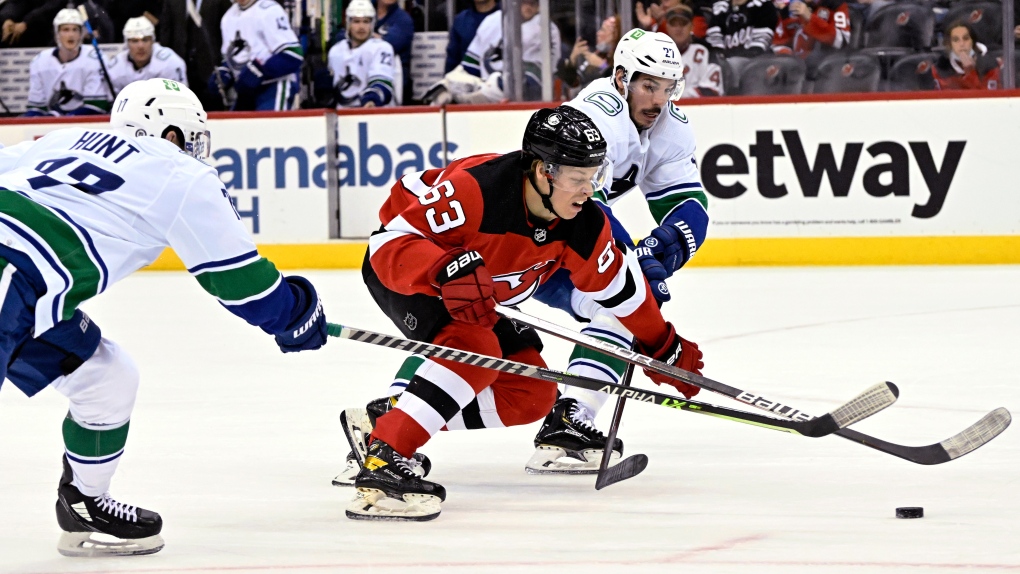 New Jersey Devils winger Jesper Bratt splits the defence of Vancouver Canucks defencemen Travis Hamonic (27) and Brad Hunt (77) during NHL action on Feb. 28, 2022, in Newark, N.J. (Bill Kostroun/Associated Press)Splitting the defence: a.k.a. splitting the D. The act of an attacking player handling the puck to skate between opposing defenders without losing posession of it.Tilt: a.k.a. 'tilly.' Slang for a hockey fight.
New Jersey Devils winger Jesper Bratt splits the defence of Vancouver Canucks defencemen Travis Hamonic (27) and Brad Hunt (77) during NHL action on Feb. 28, 2022, in Newark, N.J. (Bill Kostroun/Associated Press)Splitting the defence: a.k.a. splitting the D. The act of an attacking player handling the puck to skate between opposing defenders without losing posession of it.Tilt: a.k.a. 'tilly.' Slang for a hockey fight.
Top shelf: a.k.a. top cheese, top cheddar. When a player goes 'top shelf,' he scores a goal by shooting it into the upper part of the net.
Trailer: term used to describe a player who joins his team's offensive attack following the puck carrier.
Trapezoid: marked area in the shape of a trapezoid in which a goalie is allowed to handle the puck behind his net. If the goalie strays outside the lines,
Twig: a hockey stick.
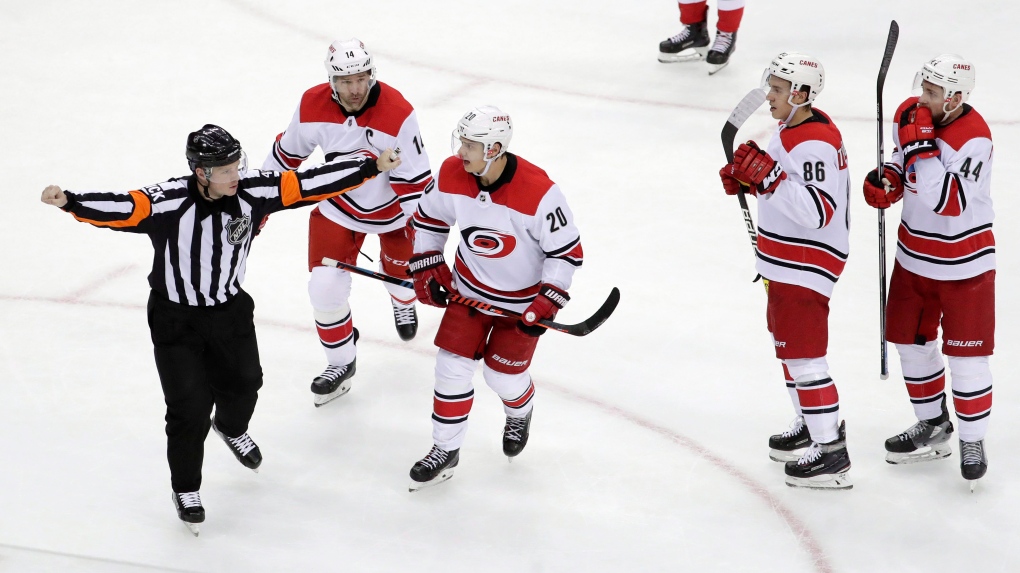 NHL referee Garrett Rank waves off a goal by the Carolina Hurricanes against the New Jersey Devils during NHL action on Dec. 29, 2018, in Newark, N.J. (Julio Cortez/Associated Press)Wave off: the action by an on-ice official indicating a disallowed goal.
NHL referee Garrett Rank waves off a goal by the Carolina Hurricanes against the New Jersey Devils during NHL action on Dec. 29, 2018, in Newark, N.J. (Julio Cortez/Associated Press)Wave off: the action by an on-ice official indicating a disallowed goal.
Whip: the 'whip,' 'whippiness' of, or 'how whippy is' a hockey stick refers to its 'flex' or stiffness, and indicates how much force/pressure is required to bend it during the follow-through of a shot. The 'whippier' the stick, the more it can bend before the puck is released during the follow-through of a shot.
Wrap-around: a player's attempt to score a goal by skating behind the net, from one side to the other, in one motion and shooting (or 'tucking') the puck in the net before the goalie or a defender stops him.
Wrist shot: the act of taking a shot by cradling the puck with the stick blade then using forearm strength and wrist movement to propel it toward the goal.
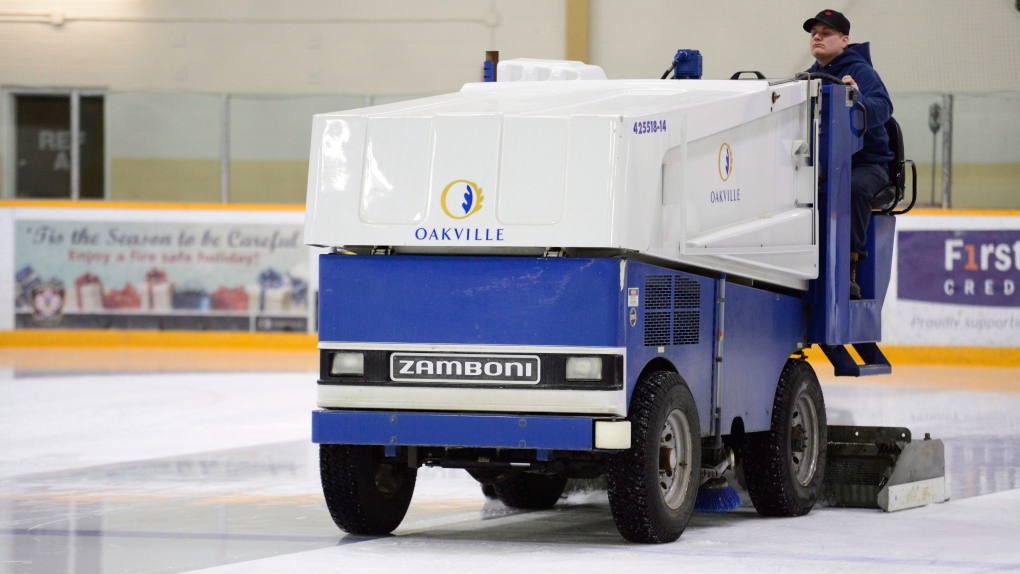 A Zamboni cleans the ice surface at a rink in Oakville, Ont., on Dec. 7, 2017. (The Canadian Press)Zamboni: the brand name of the first ice-resurfacing machine used in a rink. Frank Zamboni first created such a machine in 1947, which he attached to an army surplus Jeep. The resurfacer essentially uses a blade to first scrape the ice followed by an apparatus that sprays water and a brush that smooths the ice behind the vehicle. Olympia is another common ice-resurfacing machine brand.
A Zamboni cleans the ice surface at a rink in Oakville, Ont., on Dec. 7, 2017. (The Canadian Press)Zamboni: the brand name of the first ice-resurfacing machine used in a rink. Frank Zamboni first created such a machine in 1947, which he attached to an army surplus Jeep. The resurfacer essentially uses a blade to first scrape the ice followed by an apparatus that sprays water and a brush that smooths the ice behind the vehicle. Olympia is another common ice-resurfacing machine brand.
CTVNews.ca Top Stories

opinion Tom Mulcair: Prime Minister Justin Trudeau's train wreck of a final act
In his latest column for CTVNews.ca, former NDP leader and political analyst Tom Mulcair puts a spotlight on the 'spectacular failure' of Prime Minister Justin Trudeau's final act on the political stage.
B.C. mayor gets calls from across Canada about 'crazy' plan to recruit doctors
A British Columbia community's "out-of-the-box" plan to ease its family doctor shortage by hiring physicians as city employees is sparking interest from across Canada, says Colwood Mayor Doug Kobayashi.
'There’s no support': Domestic abuse survivor shares difficulties leaving her relationship
An Edmonton woman who tried to flee an abusive relationship ended up back where she started in part due to a lack of shelter space.
Baseball Hall of Famer Rickey Henderson dead at 65, reports say
Rickey Henderson, a Baseball Hall of Famer and Major League Baseball’s all-time stolen bases leader, is dead at 65, according to multiple reports.
Arizona third-grader saves choking friend
An Arizona third-grader is being recognized by his local fire department after saving a friend from choking.
Germans mourn the 5 killed and 200 injured in the apparent attack on a Christmas market
Germans on Saturday mourned the victims of an apparent attack in which authorities say a doctor drove into a busy outdoor Christmas market, killing five people, injuring 200 others and shaking the public’s sense of security at what would otherwise be a time of joy.
Blake Lively accuses 'It Ends With Us' director Justin Baldoni of harassment and smear campaign
Blake Lively has accused her 'It Ends With Us' director and co-star Justin Baldoni of sexual harassment on the set of the movie and a subsequent effort to “destroy' her reputation in a legal complaint.
Oysters distributed in B.C., Alberta, Ontario recalled for norovirus contamination
The Canadian Food Inspection Agency has issued a recall due to possible norovirus contamination of certain oysters distributed in British Columbia, Alberta and Ontario.
New rules clarify when travellers are compensated for flight disruptions
The federal government is proposing new rules surrounding airlines' obligations to travellers whose flights are disrupted, even when delays or cancellations are caused by an "exceptional circumstance" outside of carriers' control.


































